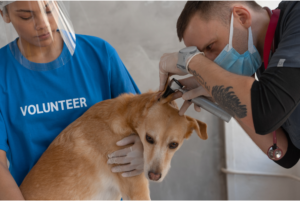What is vet tech?
A vet tech is someone who cares for animals in a veterinary setting, such as an animal hospital. They help perform routine medical care on the various types of pets that come into the facility and work with the veterinarian to provide treatment if needed. The vet tech’s day-to-day responsibilities vary depending on the facility. They may be caring for animals in the office, assisting with surgery procedures, or performing testing to help diagnose a condition.
What is a vet assistant?
A vet assistant is someone who assists vets in their work. They provide help with the care of animals, routine medical procedures, and more.
Veterinary assistants have varied day-to-day tasks that are dependent on what type of facility they work at. “The duties can range from assisting veterinarians during surgery or other treatments for sick patients to bathing dogs or cats.” This includes scheduling appointments for clients as well as handling inventory management and receptionist responsibilities. In addition to these roles,” they may also be involved in daily cleaning tasks such as mopping floors or washing cages.
Read More: he dream of becoming a veterinarian or veterinarian tech?
What’s the difference between the two?
Though they may sound like the same career, a veterinary technician and a vet tech assistant have very different jobs and choose best veterinarian for your pets by click here. Learn about their education requirements, responsibilities, and pay to see exactly how they compare. Carefully researching the differences between vet technicians and vet assistants takes time and effort, but is an important part of deciding which career path to take.
To become a certified veterinary technician, animal professionals must complete a two-year vet tech program from an accredited American Veterinary Medical Association (AVMA) school. After completing this program, graduates are required to finish state board examinations and other tests. With an Associate degree, the graduate is more experienced and has a larger knowledge base than they would have from a less advanced program.
Veterinarians do not require their assistants to have a diploma. Rather, they gain experience while working as an assistant at the clinic adjacent to the veterinarian. Requirements for veterinary assistants vary, but most applicants to educational programs will have either a general education diploma (GED) or a college degree.
A vet assistant may be certified for simpler tasks, such as cleaning and preparing rooms for pet patients. However, a vet tech would not only have to assist the veterinarian with surgeries but also participate in lab work and dispensing medication. Veterinary assistants primarily welcome visitors to a veterinary clinic. They are also the first person who greet patients on arrival and usually clean up after animals using specialized tools.
Veterinary techs work under supervision of veterinarians, but additionally, perform advanced tasks such as surgery or drawing blood from animals. Veterinarians work in a diverse range of environments; many vets specialize in one area, such as biomedical research or military.
Read More: Why Regular Vet Visits Are Necessary For Your Dog
More responsibility and a higher salary are just two of the many benefits that veterinary technicians get to enjoy. The Bureau of Labour Statistics has stated that as of 2010, vet assistants were paid $10.60 per hour and $22,040 per year ($26,616 for 40 hours), while vet technicians were being paid $14.28 per hour and $29,710 per year ($34,156 for 40 hours).
The ability for one position to fulfill more difficult tasks than the other makes the occupation extremely valuable for a clinic. Vet techs can make an entire living out of their job, while vet assistants often work full-time and hold on jobs outside of their veterinary clinic position.
When choosing between these two jobs, the major factor is whether you want a full-time position with a lot of responsibility or an entry-level job with tasks that are less important. For vets who are interested in both hospital management and hands-on caring, there are a variety of opportunities.


